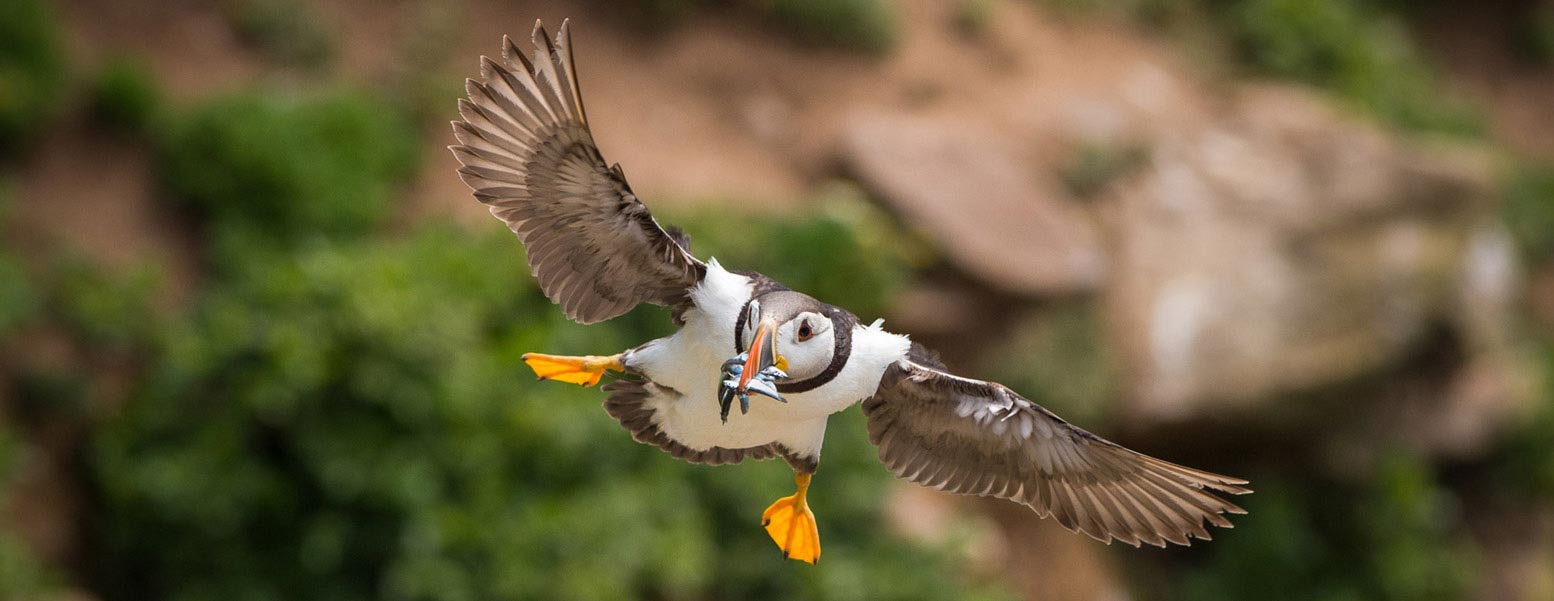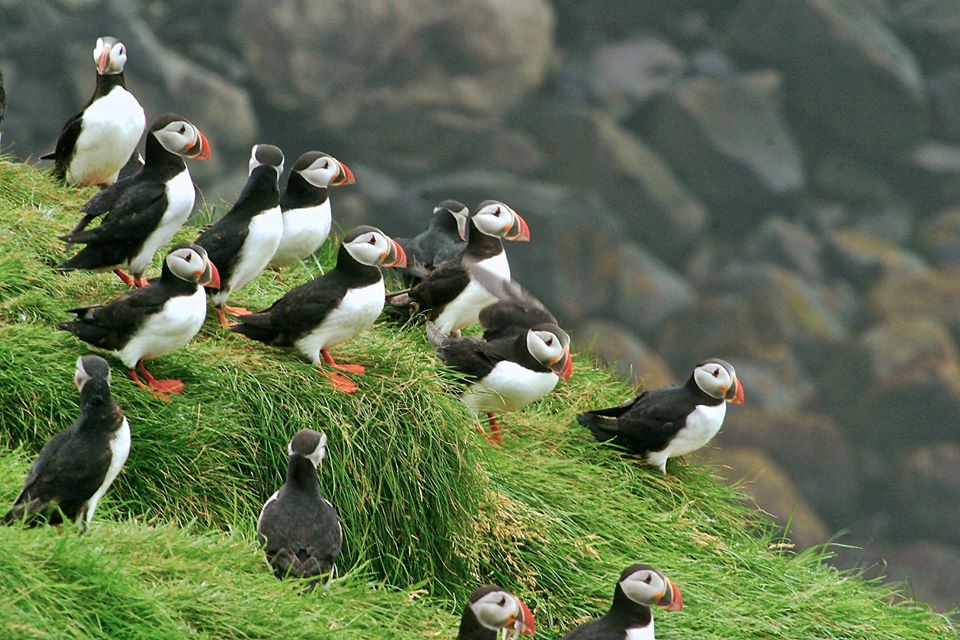We sadly closed our site to visitors on 14th March due to the pandemic. In the meantime Mother nature has been weaving her magic with abandon and gusto and the site is blooming in every aspect. Life for our flora and fauna is flourishing and in the absence of humans, Mother nature has filled the void. The weather has been unseasonably fine for this time of year which has given a helping hand to nature – flowers arch toward the sun, sea birds indulge in elaborate and time honoured mating rituals, lambs gambol in the fields under the watchful eye of their mothers, nature is in its Spring ascendancy and it truly beautiful to witness our natural world become fecund and animated again…..
THE BIRDS
Spring at the Cliffs of Moher see the annual arrival of a plethora of seabirds who choose the wonderful peaceful and safe environment of the Cliffs to raise their young each year. Without travelling over the sea to one of our offshore islands there is no better place to view seabirds in numbers than at the Cliffs of Moher. Over 30,000 pairs of nesting seabirds can be seen during the nesting period from April to
July with the months of May and June particularly impressive. The abundance of nesting sites along the cliff edges and the ability to view these from the cliff top paths make it easy for all to access this natural spectacle. The
Cliffs is designated a special protected area (SPA) for birds under the EU birds directive and we are fortunate to attract internationally important numbers of guillemot and razorbill as well as significant numbers of puffins, kittiwakes and fulmar.
Currently the birds are courting and nesting and soon the Cliff edges, stack and Goats’ island will become one giant nursery as the chicks hatch and mum and dad have to ensure they are fed, fledged and ready for fleeing the nests by late July.
 The seabird with the largest fan club is most likely the comical clown faced puffin – we are delighted that contrary to other locations throughout Europe, the numbers of puffins at the cliffs are increasing. Once paired off, puffins will generally stay with the same mate for life, returning to the burrow they dug together for subsequent mating seasons. The burrows are dug into soft soil, or are made from pre-existing holes in rocky shorelines. At the Cliffs Puffins choose to nest on Goat Island – the long low promontory below O’Briens Tower.
The male and female will rub their beaks together, a practice known as “billing.” Egg-laying season starts as early as April in more southern colonies, lasting into June for more northern groups.
Puffins lay one egg. If that initial egg is lost early enough in the breeding season, then sometimes a couple will produce another. The egg hatches somewhere between 5 and 8 weeks. The parents then take turns flying out to catch multiple fish to bring back to the baby, which is known as a “puffling.” Puffins are one of the few birds that bring food back whole instead of eating it and then regurgitating it into the baby’s mouth.
The baby is finally able to leave the burrow after 7 or 8 weeks.
Puffins live for about 20 years in the wild. The oldest known puffin lived to be 36 years old.
The seabird with the largest fan club is most likely the comical clown faced puffin – we are delighted that contrary to other locations throughout Europe, the numbers of puffins at the cliffs are increasing. Once paired off, puffins will generally stay with the same mate for life, returning to the burrow they dug together for subsequent mating seasons. The burrows are dug into soft soil, or are made from pre-existing holes in rocky shorelines. At the Cliffs Puffins choose to nest on Goat Island – the long low promontory below O’Briens Tower.
The male and female will rub their beaks together, a practice known as “billing.” Egg-laying season starts as early as April in more southern colonies, lasting into June for more northern groups.
Puffins lay one egg. If that initial egg is lost early enough in the breeding season, then sometimes a couple will produce another. The egg hatches somewhere between 5 and 8 weeks. The parents then take turns flying out to catch multiple fish to bring back to the baby, which is known as a “puffling.” Puffins are one of the few birds that bring food back whole instead of eating it and then regurgitating it into the baby’s mouth.
The baby is finally able to leave the burrow after 7 or 8 weeks.
Puffins live for about 20 years in the wild. The oldest known puffin lived to be 36 years old.
 Other seabirds that breed at the Cliffs of Moher include guillemots, razorbills, fulmars, kittiwakes, choughs and peregrine falcons.
Hope you enjoyed our overview of seabirds activities here at the Cliffs of Moher during lockdown and are heartened by nature continuing to enrich our lives with its bounty and beauty. We really miss our visitors and we will be ready with a huge “cead mile failte” when we re-open to you – we know we are blessed to live and work in such an incomparable and astounding area and really want to share it with you soon again
In the meantime, please stay safe and well and look after yourselves and each other – we will meet soon……
Other seabirds that breed at the Cliffs of Moher include guillemots, razorbills, fulmars, kittiwakes, choughs and peregrine falcons.
Hope you enjoyed our overview of seabirds activities here at the Cliffs of Moher during lockdown and are heartened by nature continuing to enrich our lives with its bounty and beauty. We really miss our visitors and we will be ready with a huge “cead mile failte” when we re-open to you – we know we are blessed to live and work in such an incomparable and astounding area and really want to share it with you soon again
In the meantime, please stay safe and well and look after yourselves and each other – we will meet soon……
Traditional Irish Blessing
May the road rise up to meet you.
May the wind be always at your back.
May the sun shine warm upon your face;
the rains fall soft upon your fields
and until we meet again
 The seabird with the largest fan club is most likely the comical clown faced puffin – we are delighted that contrary to other locations throughout Europe, the numbers of puffins at the cliffs are increasing. Once paired off, puffins will generally stay with the same mate for life, returning to the burrow they dug together for subsequent mating seasons. The burrows are dug into soft soil, or are made from pre-existing holes in rocky shorelines. At the Cliffs Puffins choose to nest on Goat Island – the long low promontory below O’Briens Tower.
The male and female will rub their beaks together, a practice known as “billing.” Egg-laying season starts as early as April in more southern colonies, lasting into June for more northern groups.
Puffins lay one egg. If that initial egg is lost early enough in the breeding season, then sometimes a couple will produce another. The egg hatches somewhere between 5 and 8 weeks. The parents then take turns flying out to catch multiple fish to bring back to the baby, which is known as a “puffling.” Puffins are one of the few birds that bring food back whole instead of eating it and then regurgitating it into the baby’s mouth.
The baby is finally able to leave the burrow after 7 or 8 weeks.
Puffins live for about 20 years in the wild. The oldest known puffin lived to be 36 years old.
The seabird with the largest fan club is most likely the comical clown faced puffin – we are delighted that contrary to other locations throughout Europe, the numbers of puffins at the cliffs are increasing. Once paired off, puffins will generally stay with the same mate for life, returning to the burrow they dug together for subsequent mating seasons. The burrows are dug into soft soil, or are made from pre-existing holes in rocky shorelines. At the Cliffs Puffins choose to nest on Goat Island – the long low promontory below O’Briens Tower.
The male and female will rub their beaks together, a practice known as “billing.” Egg-laying season starts as early as April in more southern colonies, lasting into June for more northern groups.
Puffins lay one egg. If that initial egg is lost early enough in the breeding season, then sometimes a couple will produce another. The egg hatches somewhere between 5 and 8 weeks. The parents then take turns flying out to catch multiple fish to bring back to the baby, which is known as a “puffling.” Puffins are one of the few birds that bring food back whole instead of eating it and then regurgitating it into the baby’s mouth.
The baby is finally able to leave the burrow after 7 or 8 weeks.
Puffins live for about 20 years in the wild. The oldest known puffin lived to be 36 years old.
 Other seabirds that breed at the Cliffs of Moher include guillemots, razorbills, fulmars, kittiwakes, choughs and peregrine falcons.
Hope you enjoyed our overview of seabirds activities here at the Cliffs of Moher during lockdown and are heartened by nature continuing to enrich our lives with its bounty and beauty. We really miss our visitors and we will be ready with a huge “cead mile failte” when we re-open to you – we know we are blessed to live and work in such an incomparable and astounding area and really want to share it with you soon again
In the meantime, please stay safe and well and look after yourselves and each other – we will meet soon……
Other seabirds that breed at the Cliffs of Moher include guillemots, razorbills, fulmars, kittiwakes, choughs and peregrine falcons.
Hope you enjoyed our overview of seabirds activities here at the Cliffs of Moher during lockdown and are heartened by nature continuing to enrich our lives with its bounty and beauty. We really miss our visitors and we will be ready with a huge “cead mile failte” when we re-open to you – we know we are blessed to live and work in such an incomparable and astounding area and really want to share it with you soon again
In the meantime, please stay safe and well and look after yourselves and each other – we will meet soon……

